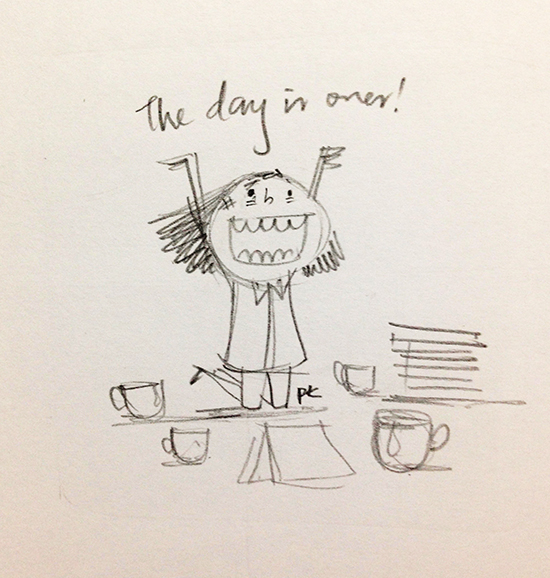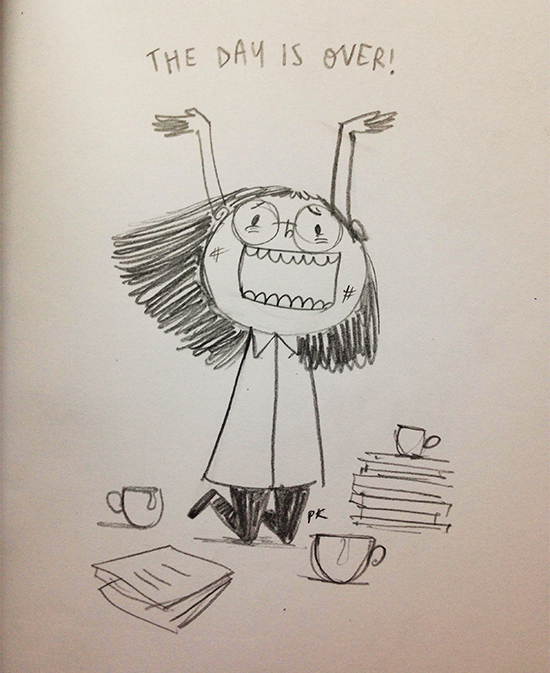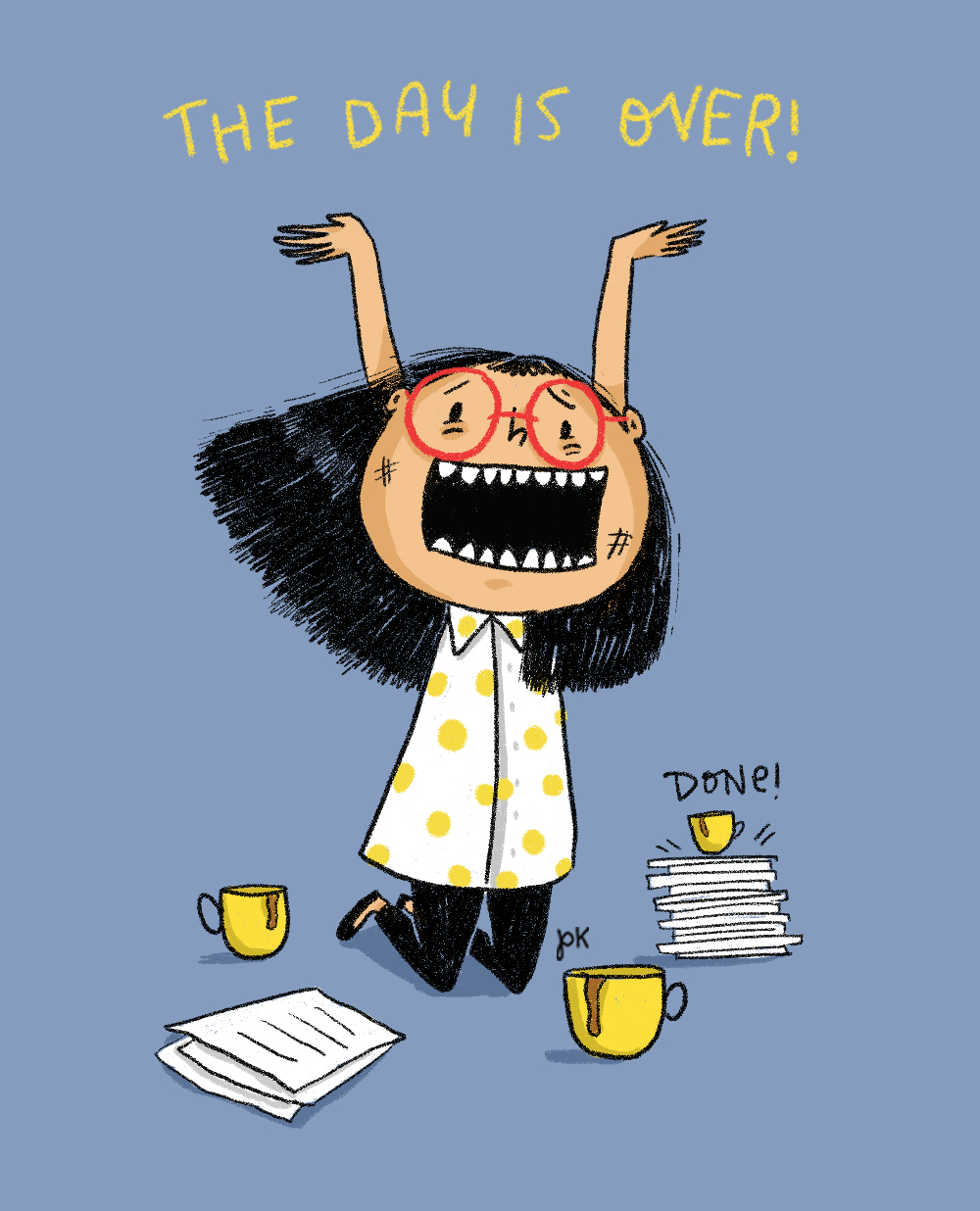
In this post, I’ll talk about how to be an illustrator (every illustrator has their own techniques, I’ll be elaborating on mine), my tools of trade & inspiration.
I will be answering @delhidoodler08’s questions.
“What advice would you give to someone who wants to learn illustration? Which tablet and software do you use? Who/what is your biggest source of inspiration?”
And also, @thatgraciasgirl’s question,
“How did you develop your style of illustration, what was the process?”
Before I begin elaborating each of the above, let me help you understand a very simple concept.
As children, we were taught to hold a pencil and trace alphabets. Eventually, we learnt how to use a tool – the pencil.
We all learnt the same tool – yet our handwriting is different because it reflects who we are as a person.
The same concept applies to illustration. Knowing a software isn’t enough to be an illustrator. You have to practice to develop your own style which will mould depending on your personality, thoughts, interests, etc.
My tools of the trade:
1) Pencils! I usually use 4B pencils for smoother strokes
2) Software- Adobe Photoshop & Illustrator – I use either of these to digitize my illustrations.
3) Wacom Intuous 4 – I use this tablet to retrace over my scanned illustrations. The pressure sensitivity of this pen is beautiful and helps to recreate the desired strokes. Although I’m excited to upgrade soon!
How to be an illustrator & how does one develop their own style?
1) Observe

Back in Art College, we drew people or objects for 30 minutes every morning. Most of us hated this session, though I realised the importance of these 30minutes much later.
Observing your environment, people, human behaviour, objects, shapes, thoughts, etc. is important for an artist. And documenting these on paper is a practice we must develop for improvement. Just like journaling! At first, your humans may not even look like humans, but it’s important to keep observing and keep practising. The best lesson is to observe.
2) Draw, draw, draw!
I upload #pranitasdrawingaday on Instagram everyday. It has been almost 1000 days now. This project started for the sake of practice – to observe not only visual objects but also my thoughts and feelings. This helps in developing your own style & also trying new techniques.
3) Learn how to draw gestures, expressions
The best way to draw expressions, gestures, etc. is to look in the mirror and observe.
For example, if you want to draw a sad face, you emote it in front of the mirror and try imitating it on paper until you perfect it.
You will notice your eyebrows wrinkled, your lips pouting, your face drooping, etc. – observe the change and adapt it.
Don’t worry, after a while, you will not need to do this. You will automatically be able to visualise the expressions. (Disney animators used to have mirror beside their desk.)
Sometimes, referencing your own body and face is way simpler and more effective than the internet!
4) Build confidence
Try and be passively aware and observant. [this is a mental practice that you can build – it will be as obvious as breathing overtime.]
If you observe something and want to draw it, use your pen to create a quick scribble. Using a pen will allow you to build your confidence because there is no room for corrections. Developing this habit overtime will help you quickly jot your ideas/thoughts on paper.
Using a pen to jot down your thoughts and ideas within a few seconds/minutes is a great way to think faster.
5) Learn to simplify and analyse
Let me explain this with an example. My subject is a bear. My illustration demands a middle aged bear character. Now in real life, you can’t really tell the age of a bear. But in the world of your illustration; it’s possible. All you have to do is analyse the thought – what can make the bear look older? And communicate the thought as simply as possible.

I added age on the bear by analysing and simplifying the thought. However, to expand this further, you can also add a slight hunch, droop the smile more, etc.
6) Develop your own style
Developing an illustration style is just like developing a personality – like I mentioned in the beginning of this post.
If you keep practising, keep observing – not only objects but also your feelings and thoughts, and documenting them as illustrations on paper – you will automatically develop a style over time.
Your personality, likes and dislikes will automatically be seen in your illustration style.
One very important factor to consider is – do not imitate another illustrator’s style. This will only limit you to the illustrator’s identity. You will not be able to explore and express yourself!
Developing your style will require lots of practice – not only drawing practice but also thinking.
7) The process
Everyone’s process is different depending on their style. But while working with a client, I believe in presenting a very detailed process so you can avoid changes, understand the direction of the project and assure your client of authenticity. I’m sharing my process here below, though one must do what is most comfortable for their style.
Example,
- Write your idea in words: A girl has had a long day, she looks tired. But she is happy and excited that her day is finally over.
>> Tired girl looking very excited, coffee mugs and papers fallen around. - Create a thumbnail of your layout.

- Create a rough sketch on paper

- Create a linear illustration digitally of your rough (this depends on your illustration style. This style has outlines.)

- Colour your illustration

Having a detailed step by step procedure not only helps your client understand your process, but lets you improvise at each stage.
Tip: It is always good to go back to your illustrations after a while to look for room for improvement.
7) Kick your fear away!

During college days, I often feared what my final artwork would look like and was obsessively careful of my process. Be fearless! It will take time to build this confidence. Constantly remind yourself that you can always redraw over and over, you have lots of scope for improvement. Wanting good results and setting goals is good, but constantly beating yourself because of a perfectionist attitude will only slow you down. Believe in the process, and be fearless!
8) Who inspires me the most?
My inspirations are constantly changing as I constantly change and grow.
The source of my inspiration almost always is books. I love reading, and the people who inspired me over the last one year were discovered through books.
My inspirations are mostly people who make me want to work hard, who keep me motivated and remind me of my goals.
Malala Yousafzai’s undying spirit reminds me that if you are determined enough you can achieve your goals. This keeps me going! [Read her book – I am Malala]
And also, Dory (from the movie Finding Dory/ Finding Nemo) is also an inspiration. I love how her character is imperfect and flawed (I’m a forgetful person, too!) – yet she sticks to beliefs and moves on – just keep swimming, just keep swimming, just keep swimming!
If you have any questions feel free to write to me at otherpranitakocharekar@gmail.com with “Questions” as the subject.
I would love to create a conversation with you, if you have anything to add to the post, feel free to drop comments. We learn from each other! 🙂
I hope this was helpful and I truly hope you have a more productive day today (and always!)
Have a lovely day!
Love,
Pranita.
Want to hear more about upcoming blog posts, new product launch, giveaways, promo codes, etc.? Just fill in your details and hit subscribe! 🙂

Yay! Thank you so much for answering my questions so so well, Pranita!!! And High 5 for finding Dory Inspirational 😀 *Just Keep Swimming*
So glad it was helpful! 🙂
Thank you Pranita. Thank you so much 🙂
You’re welcome, Nikhil! 🙂
Hi pranita! I’d asked very similar questions to shamika. You both are my inspiration. Thank you for writing this post!!! Hopefully, I will put into practise what I’ve read today
I have a question for you. You described your whole illustration process. And in that process my question is how do you suggest I jump from step:rough sketch to step: linear illustration of the rough sketch? How do you do it? Can you give a detailed account?
Hi, thank you! 🙂
I use my Wacom tablet to retrace it on my computer using Photoshop. The strokes & style will develop over time for which you must practice lots on paper first. Practice will help you achieve this.
Love this article 🙂
Thank you! 🙂
Hi Pranita, I quit my job as from an architecture firm and wanted to explore multidisciplines. This blog post gave me the confidence to push and just do it. Thank you sooo much
So happy to hear that it helped you! Ace it 🙂
Great Article Pranita. Learnt. Inspired. Loved it
Thank you Praveen, so glad it helped!
Hey pranita. I really like the article it’s so full of good vibes. It’s always hard to believe in the process. We all try to be perfectionist at one point and ultimately ruin our own work.
Kuddos to your efforts and your work.
Glad to hear & thank you so much! 🙂
Thank you for this Article. it inspires and motivate me.
So happy to hear this! Thank you!
Hi Pranita! This post was quite helpful, thank you so much! I’ve been a bit stuck lately and I feel like I have more direction now. Thanks 🙂
So glad to hear this, Naina! Hope all is well 🙂
First off,
It’s amazing. This is my first drawing tablet and I couldn’t be any happier with it. It works PERFECTLY and I do love the software it came with (although it’s a little wonky at times). I’d recommend this to anyone who draws or even does photography.
Appreciate it!
I spent a great deal of time to find something like this
Well, welcome to my page then! 🙂
HI Pranita, dude your article is just like your skills; inspiring, clear, and cheerful…… I aspire to become an illustrator, can you please recommend any art institutions or colleges for the same…. Where’d you learn the skillset and where are you from. Thank you so much for the motivation. P.S. I love you girl keep going
Thanks for the love! I went to Rachana Sansad College of Applied Arts 🙂
Wow, thank-you so much! This is very helpful! 😀
So glad it helped! 🙂